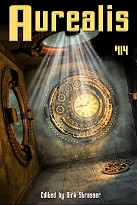“Fail” by Sarah Napier
Reviewed by Tara Grímravn
There are three original stories in September’s issue of Aurealis.
“Fail” by Sarah Napier
Set in a futuristic London, sex-addict Nate loses the one woman he truly loves thanks to a technological malfunction. But was it real? Napier’s story was quite interesting, to say the least. As the author states, the intent was to examine society’s growing dependency on technology, but it was her focus on how such things will affect human relationships which I found intriguing. After all, I’ve had plenty of conversations on this exact topic myself.
In terms of the story itself, I felt it was very well-developed. The third person present tense point of view lends the story a sense of immediacy, which I think helped increase the tension nicely. And while this isn’t exactly a slow story in terms of pacing, it was definitely helped along by the added tension.
Her characterization of the protagonist Nate was good and I felt I had a decent grasp of his personality. I didn’t like him, but that I was able to feel a slight twinge of horror at the malfunction that caused him so much trouble means that Napier was successful in this area at least. The ending was particularly enjoyable, especially since it was something I really did not see coming.
“A Figure in the Haze” by Rebecca Boyle
A nurse, Ava, moonlights as a soul collector for an unusual company, having second thoughts only after trying the product. Boyle’s story is bleak, for lack of a better word—excellent but bleak. The protagonist here is more of an anti-hero who appears to have lost her compassion, or really any liking in general for her fellow humans. This attitude is due to a multitude of circumstances, not the least of which are mistreatment at the hands of patients and regularly having to watch them die. So, she accepts an offer that allows her to profit from their deaths, even going so far as to hope for an epidemic (and even helping one along).
The catalyst that causes Ava to have a change of heart is reminiscent of events in Edgar Allan Poe’s “The Tell-Tale Heart.” Instead of a beating heart that only the protagonist can hear, however, it is the scream of a soul.
The pacing moves along quickly and Boyle has done a great job of holding the reader’s interest and setting the scene. All in all, it’s a great story and I thoroughly enjoyed reading it.
“The Glassblower’s Peace” by James Rowland
A young Venetian soldier helps an old sorceress stop an invading army. Of all three stories in this issue of Aurealis, I liked this one the best. It’s an absolutely delightful fantasy tale. The characters of Tomaso and Giulia were incredibly well-developed and I really felt like I was able to develop a rapport with them.
The setting was elaborate and Rowland’s description of the city, of the Glassblower’s house, and the elements of magic are excellent. I really appreciated the inclusion of cultural information, which helped to build this alternate version of Venice in a previous century.
Rowland chose to write “The Glassblower’s Peace” in the third person past tense, which seemed quite appropriate. The story didn’t need the immediacy or tension that present tense provides. It flows very well on its own and the action held my attention throughout. The ending was both bittersweet and poignant, which I absolutely loved. I highly recommend this story.
 Aurealis
Aurealis